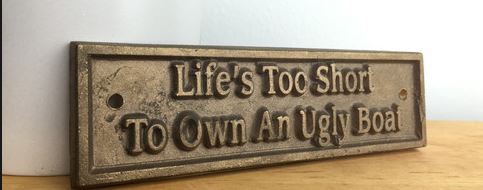Chesapeake Log Canoe Mystery #TBT "Slack Away, Aunt Suzy" from the September SpinSheet 2006 ...
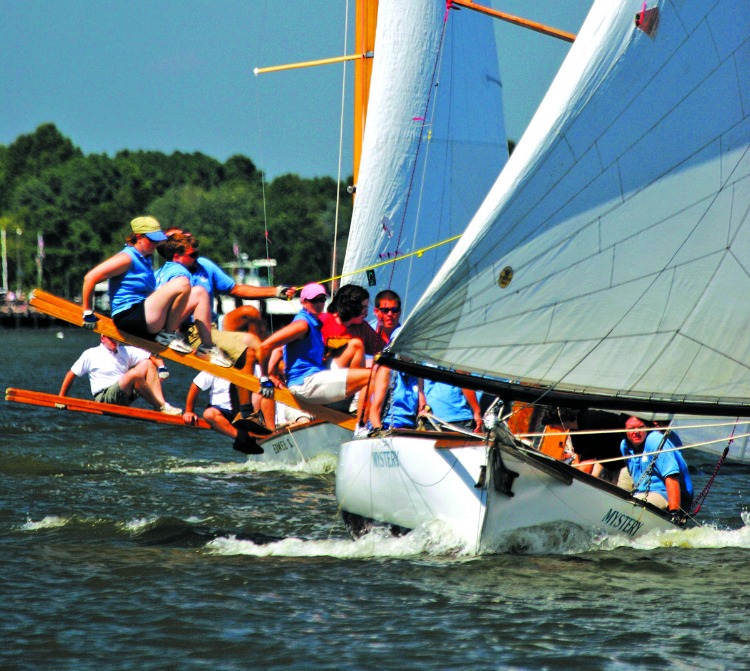
Whenever he meets someone he thinks is a little batty, my dad says they have “a few loose screws.” Last weekend, when I arrived at the Belleview-Oxford Ferry launch to find the log canoe crew I’d be racing with for the first time, a teenager named Willie Leaverton dropped a nut overboard as the crew was securing the wooden mast.
I asked his older brother Kyle, who has crewed on the boat for six years, if the lost nut belonged to an important bolt. He said, “Yeah, the deck could split in half.” That would be bad. The crew jury-rigged a tie solution to prevent it, without any visible stress, and kept on rigging and ribbing Willie, who shrugged it off. Before the sails were even up, my dad’s loose screw expression already seemed an apt metaphor for log canoe racing.
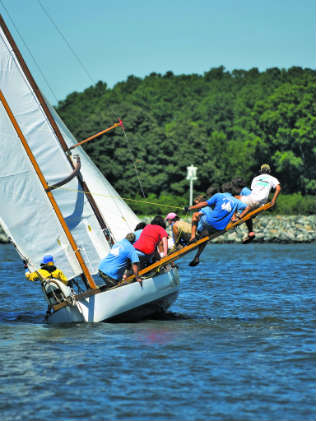
I watched this labor-intensive rigging process while talking with Jimmie Glen, who’s been sailing on Mystery for 45 years. She’s a fount of information from the boat’s history to the crew news. Jimmie sits on the outrigger off the stern–in full foul weather gear on a sunny August morning–and controls the sail from a little seat that is the only boat part made of plastic. She explained to me that on a log canoe, the foremast is the mizzen, and the aft mast is the main.
A couple in their late 50s who run a saw mill in Chestertown, the Schaubers, or Uncle Fran and Aunt Suzy as the younger crew call them, own the boat. A few decades ago, they met at the Miles River YC when she was cruising with her parents, and he was sailing on Mystery, as he has now for 40 years. Having refurbished and reconfigured every aspect of her, Fran could fill a book with what he knows about his boat. Here’s the short version: It’s a 74-year-old canoe, based on an indigenous Indian design, made of hand-hewn logs.
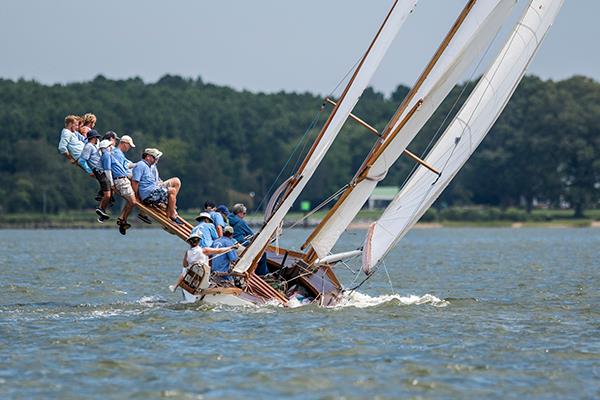
The boat has two wooden masts with larger sails, rigged with wooden sprits or spars, a kite, and a staysail. There are no cleats or stop blocks for sheets; nor are there winches, shrouds, or lifelines. If you need to grab something for balance, you have a choice of leaning on a mast or a crew shoulder. If you want to bring a jacket and sun block aboard, you have to strap them on, since there is a lack of storage space and a possibility of capsizing.
Ron Mullar, who’s been sailing on Mystery for 14 years, told me how they capsized one time at the start of the first race. Like all the log canoes, they have their own chase boat for such situations. They towed the boat back to shore, de-rigged her, bailed, re-rigged her, headed out to the second race having missed lunch, and capsized her again at the start. He told the story with a big smile (more confirmation on the looney loose-screw theory).
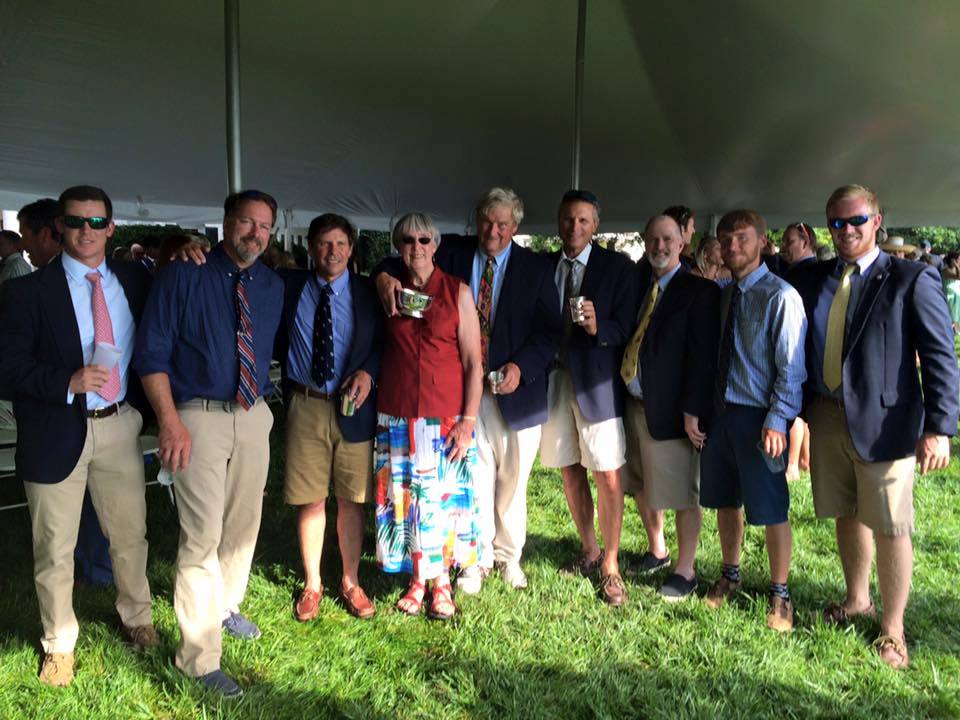
What comes out of Fran’s mouth is a compelling mix of information and humor, but you have to tune in to catch it. When the breeze turned flukey, he grumbled, “I hate this river.” When it picked back up, he said, “I love this river.” His opinion shifted later, as did the breeze. He explained to me how some of the log canoe racers have gutted out the logs and replaced them with fiberglass and modern gear to make them faster. With a straight face and a heavy sigh, he claimed that, since it was tougher to beat these lighter boats, he wasn’t sure he’d be doing this much longer. I’d only known the man for an hour, and the thought of him quitting made even me laugh.
He said, “The problem with these boats is that you have too many lines and too many people.” Then he flashed a little grin. Ron chimed in to say, “The real problem is that he moves all the lines over the winter, and we can’t find anything.” Fran looked off in the distance and said, “I’m going to get me one of those make-believe log canoes.”
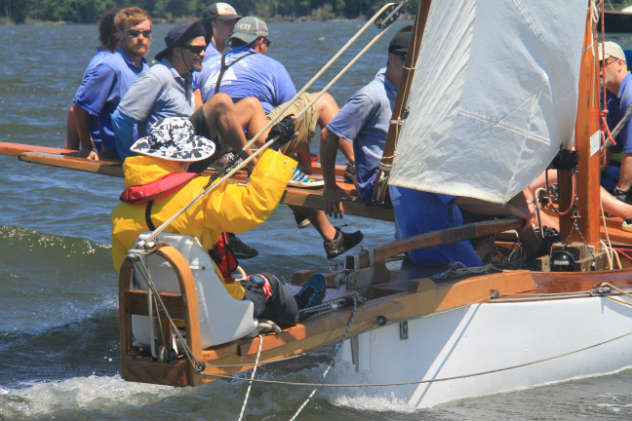
The nuttiest part about log canoe racing, by far, is the board thing. Every time you tack, you have to climb downhill on this plank, where you’ve been precariously balanced over the water in a tangle of bodies, throw this heavy chunk of wood across the boat, tuck it back in, and climb back up as one or more crew yells, “Weight! Weight up!” The rush of being out on this bizarre pirate plank of sorts is much like that of hiking out on a trapeze, but there’s no tether. The board is only eight inches wide. It’s tricky.
The lingo on this boat was a simplified version of anyone’s sail-speak. All the crew needed to know was “weight” (climb up) or “weight in” (climb down). “Weight in” voiced more loudly meant “crew to leeward.” A student at Wilmington College and a good-spirited soul, Kyle Leaverton is relied upon to tweak the downhaul, lift the centerboard, and communicate changes from mast to mast. In the breeze, with him behind me, he kept saying something that sounded to me like, “Sock away, Aunt Suzy.” I thought it was log-canoe-speak for “ease.” When I asked him about it, he said he’d been saying “slack,” not “sock.” He gave me a “Duh!” look.
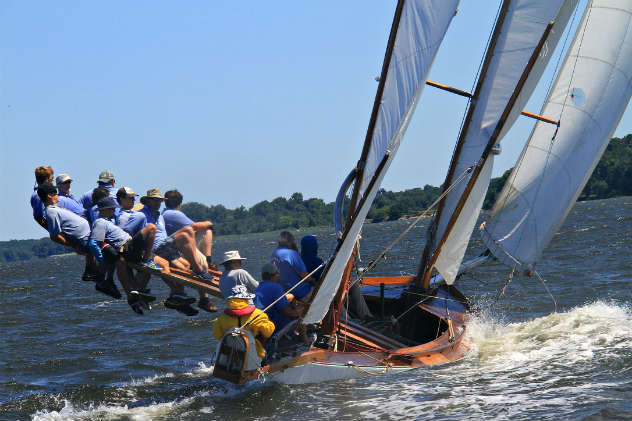
Word traveled efficiently on this boat in the echo method from forward to aft and vice versa. I noted our potential collision course with the ferry. Holding her foresail sheets, Suzy said, “Look out for the ferry.” Someone behind her yelled, “Ferry!” Fran said, “Ignore the ferry.” From the helm to leeward where he couldn’t see much, Mitch said, “Ignoring the ferry.”
Some sailors have an aura about them as if they were born with a tiller in their hands, and Mitch Grieb is one of them. He has been sailing on Mystery for 36 years. This knowledge would leave you scratching your head and thinking that this skipper is either a decade and a half older than he looks, or he was indeed a helms-baby. He doesn’t talk much. When he says, “Quiet,” the crew shuts up.
Mitch must know a little something about the Tred Avon River since that ferry stopped for us. No ferry has ever stopped for me in an ordinary sailboat. I’ve never been on a boat as widely photographed by passers-by. One little boat hovered, and a passenger called out, “You look beautiful!”
This log canoe requires more work than any sane sailor–with all screws secured–would be willing to do. It gets waterlogged (so to speak) if you don’t haul it every time. The crew has to crawl like crabs up and down at every puff, and they go home with back aches from all that board-throwing. One good header, and a few crew get dunked and dragged, clinging on to the plank for dear life.
But there is a magical feeling sailing on a wooden boat. Maybe it’s a yearning for purer times, a visceral tug to a place we may not have known in our lifetimes, but we’re sure it was better. At one point when the breeze filled in, Suzy said to knock on wood. Without having to search for wood, the crew just knocked. When we stopped at the Tred Avon Yacht Club at the end of Saturday’s races, among the many details that made me smile that day was a bumper sticker on a boat trailer. It read: “Life is too short to sail on ugly boats." Amen.
~Molly Winans, September SpinSheet 2006
